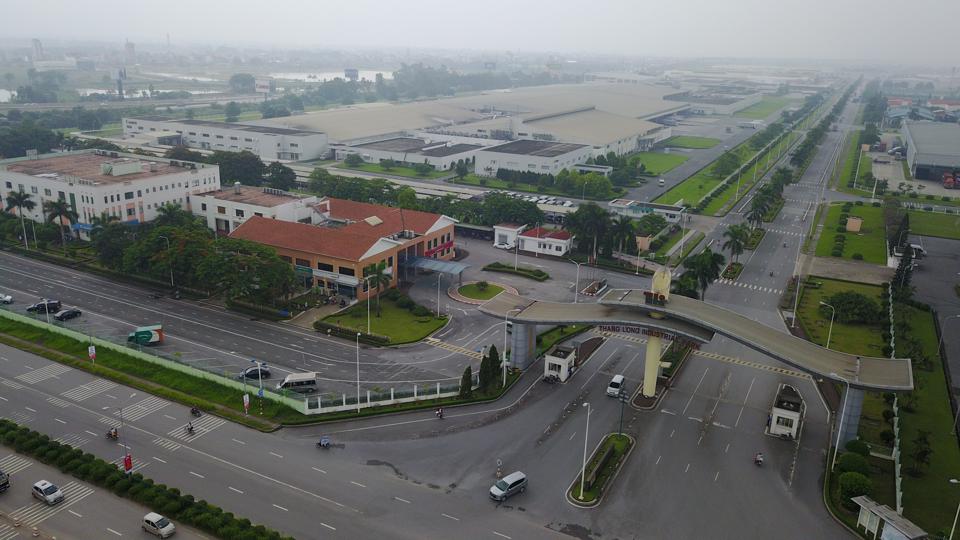High-quality FDI projects drive recovery of real estate market
Reopening the economy is key to keeping the strong inflow of FDI into economic sectors.
Vietnam’s policy of opting for high-quality FDI projects has started yielding strong results despite the severe impacts of Covid-19 on the global economy, said Vice Minister of Construction Nguyen Van Sinh.
Sinh made the comments while introducing the ministry's January-March report on the real estate market recently. He said Vietnam remains an attractive and safe investment destination for multinationals, especially in industrial properties.
The strong return of foreign direct investment (FDI) into the real estate market in the first quarter of 2022 has been a positive factor in supporting its recovery in the the-post pandemic period.
| Thang Long Industrial Park in Hanoi. Photo: Pham Hung |
The January-March period saw the strong inflows of FDI into industrial parks. In late February, Framas Group, a German company that specializes in the manufacturing of injection molding machines, signed a 10-year contract to lease a ready-built factory area of 20,000 square meters in KTG Industrial Nhon Trach 2, Dong Nai Province.
The authorities of the southern province Binh Duong in mid-March awarded an investment license for LEGO (Denmark) to build a toy manufacturing plant worth US$1.3 billion, while BW Industrial Development acquired the 74,000-square-meter DEEP C Industrial Park from Bac Tien Phong Industrial Park, Quang Ninh Province.
The return of foreign investors helped lift the occupancy rate in industrial parks in the North to 80% during the first quarter of 2022, with the land rental fees of around $109 per square meter, up 9.2% year-on-year.
In the south, the occupancy rate stood at around 85% with rental fees of $120 per square meter, up 9%.
Insiders said that the Government’s decision to reopen the economy was key to keeping a strong inflow of FDI into economic sectors. n
Data from the Ministry of Construction revealed total FDI commitments to Vietnam reached nearly $9 billion in the first three months, in which the real estate market ranked second among the sectors behind manufacturing and processing with $2.7 billion, accounting for 30.3% of total capital and up 213% year-on-year.
Challenges and opportunities
Since early 2021, the shift in investment flows from China to Vietnam amid the Covid-19 impacts, coupled with a series of free trade agreements (FTAs) in place, has led to high demand for industrial properties.
In this context, new industrial parks are being built across provinces/cities to meet the growing demand from domestic and foreign investors.
In Hanoi, the municipal People’s Committee has signed a decision to build two to five new industrial parks in the 2021-2025 period, including those in Soc Son, Dong Anh, Bac Thuong Tin, Phu Nghia, and Phung Hiep.
The Bac Ninh authorities have also pushed for the construction of Que Vo II and Gia Binh industrial parks. In Quang Tri province, the projects on Quang Tri and Trieu Phu IPs are being accelerated while Long Duc 3 and Bau Can IPs are expected to be completed in Dong Nai Province soon.
While there is strong interest in Vietnam’s industrial parks, there remain concerns over the existing IP model, which requires further modification to better adapt to the current situation.
Former director of the Foreign Investment Agency under the Ministry of Planning and Investment Phan Huu Thang said the majority of areas for rental are for production, rather than for logistics and other supporting facilities.
“Cumbersome administrative procedures continue to be a hindrance for investors, for which greater efforts are required to ensure a more transparent and convenient environment to lure more investment capital into Vietnam,” Thang said, referring to fierce competition from regional countries for global FDI.
Meanwhile, an insufficient infrastructure system could also affect investors’ decisions to invest. A report from the Ministry of Planning and Investment (MPI) noted that 16% of foreign-invested companies have moved orders to other countries, and 18% are considering this option.
“Vietnam should promote a new industrial park model with a focus on modern and environmentally friendly technology,” the MPI’s report noted.
“It is essential for Vietnam to avoid developing industrial parks purely for the objective of utilizing land resources,” said the ministry.
| “The reopening of the economy has built confidence among foreign investors and opened up new opportunities for the real estate market in 2022, including industrial properties. The strong support from the Government for investors and the adaptability of local firms could also spur the growth of the market in the coming time,” Vice Director of Savills Vietnam John Campbell. |











